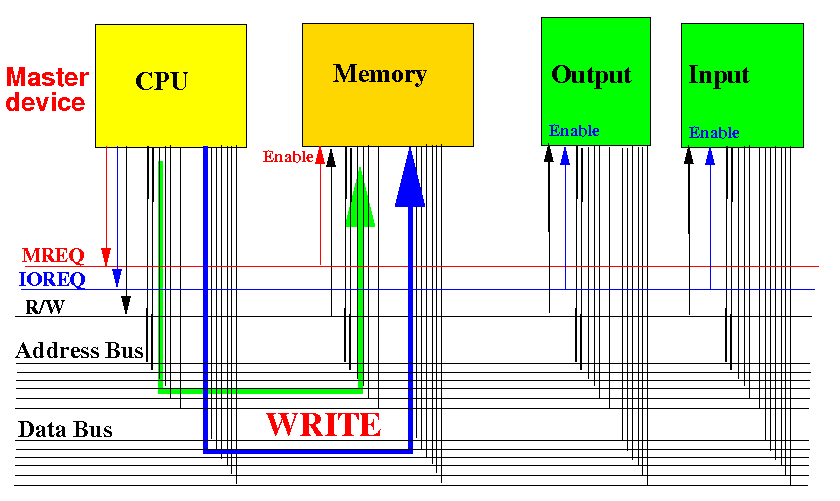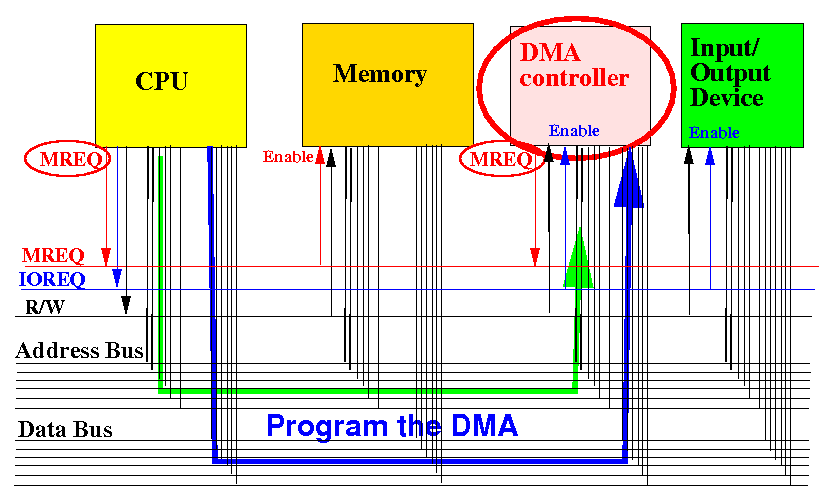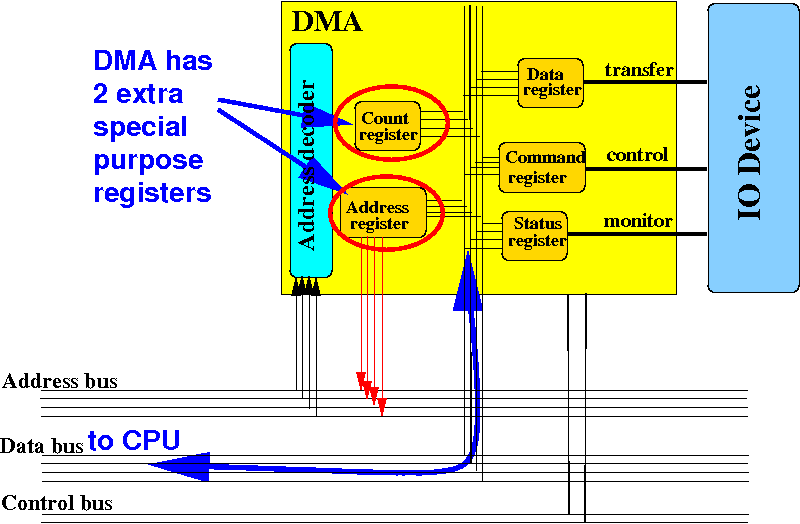The Direct Memory Access technique
Modern computer systems
always use
DMA
for IO communication
Review:
data transfer from an input devices
- In an
input operation,
data is transfered
from
an input device
to
the memory:

- However,
the transfer operation is
not as
in the figure above
(because this requires
the input device to
initiate a
bus protocol)
|
Review:
data transfer from an input devices
- In an input operation,
a
"smart" device
(e.g., the
CPU) will first
initiate a
read operation to
the input device:

- (Because
the input device
is not capable to
initiate a
bus protocol)
|
Review:
data transfer from an input devices
- Then
the CPU will
write the
data to the
memory:

-
Note:
a similar procedure
is used to transfer data to
an
output device
|
Data transfer using the DMA technique
The DMA controller
(= a "smart" device like
the CPU (Central
Processing Unit)):
- The DMA technique uses
a DMA controller:

- The DMA controller
can
initiate
a (data transfer)
bus cycle !!!
|
Data transfer using the DMA technique
How the
data transfer
occurs in the
DMA technique:
- The CPU
first
programs the
DMA controller
with a data transfer
command:

- (The DMA controller
is like a
helper processor
for the CPU !!!)
|
Data transfer using the DMA technique
How the
data transfer
occurs in the
DMA technique:
- After receiving the
data transfer command, the
DMA controller
will perform
the data transfer:

- The DMA controller
first
reads the
IO device
|
Data transfer using the DMA technique
How the
data transfer
occurs in the
DMA technique:
- The DMA controller will
then
write the
data to
memory:

- (The
CPU is
free (available) to
do "other"
more important
computations)
|
Non-dedicated DMA controller
- A
non-dedicated
DMA controller is
a stand-alone
DMA controller that
can communicate with
multiple/different
IO devices:

- A non-dedicated
DMA controller typically
manages
multiple
slower
IO devices
(like keyboard,
printer, etc)
|
Non-dedicated DMA controller
- A
dedicated
DMA controller is
an integraded
DMA controller that
controls
one specific (type) of
IO device(s):

- A dedicated
DMA controller typically
manages
one or more
faster
IO devices
(= hard-disks !!)
|
Structure of
a DMA controller
A DMA controller has the following
structure:

All special purpose registers
on the DMA controller can be
accessed (read/write) by the
CPU
Capability of a DMA controller to initiate
a bus protocol
The DMA controller
has the ability to
initiate
a READ/WRITE operation
on the system bus:

I.e.: the
DMA Controller can
send
address and
READ/WRITE req
to
memory and
IO devices!
Functions of the
special purpose registers in
the DMA controller
- Status register:
readable by the CPU to determine the
status of the
DMA
controller (idle, busy, etc)
- Command register:
writable by the CPU to
issue a command
to the DMA controller
- Data register: readable and writable.
It is used to buffer
the data
that is being transfered between
the
memory and an
IO device.
-
Address register:
contains the
next memory location
of
memory
where from or where to the
data will be
transfered.
The Address register
will be programmed
by the CPU
before
the CPU issues
a READ/WRITE command to the
DMA controller.
-
Count register:
contains the number of bytes
that need to be
transfered.
|
Operation of a DMA controller
Actions taken by
the DMA when
performing a
READ (from memory)
transfer to
an IO device:

The DMA
first
read the
memory data at
the address at
its Address Register
using a bus cycle
Operation of a DMA controller
Actions taken by
the DMA when
performing a
READ (from memory)
transfer to
an IO device:

The DMA
then
writes the
data from
its Data register
to the IO device
Operation of a DMA controller
Actions taken by
the DMA when
performing a
READ (from memory)
transfer to
an IO device:

The DMA
decrements the
Count reg
and
increments the
Address reg
to prepare to the
next transfer.
The DMA will
repeat the steps
until Count Reg = 0
Operation of a DMA controller
Actions taken by
the DMA when
performing a
WRITE (to mem)
transfer from
an IO device:

The DMA
first
read the
data
from the IO device
Operation of a DMA controller
Actions taken by
the DMA when
performing a
WRITE (to mem)
transfer from
an IO device:

The DMA then
writes
the data in Data reg
to memory at the
address
given by
its Address Reg
Operation of a DMA controller
Actions taken by
the DMA when
performing a
WRITE (to mem)
transfer from
an IO device:

The DMA
decrements the
Count reg
and
increments the
Address reg
to prepare to the
next transfer.
The DMA will
repeat the steps
until Count Reg = 0
How does the
CPU use a
DMA controller
- The DMA controller is
like a helper processor to
the CPU !!
- How does the
CPU
delegate the
IO operation to
the DMA controller:
- The CPU first
setup the
task that the
DMA controller must do by
writing the
DMA's
Address Register
and
Count Register
The Address Register and
Count Register
specify the
location and
amount of data of the
data transfer operation
- The
CPU then
issues a
READ or WRITE command
to the DMA controller
This will make the
DMA controller
active
and the
DMA controllor will
execute the
operations
specified in the last 6 slides.
|
|
Example:
how the CPU delegate the IO operation to the DMA
Suppose the
special purpose registers of the
DMA is
memory-mapped to
the following
addresses:

(Since the CPU will
not use the
DMA's Data Register,
we don't need to assign
it an address...)
Example:
how the CPU delegate the IO operation to the DMA
An example of
the CPU instructing
the DMA that
controls a
printer to
print a string:
movw r1, #:lower16:myString
movt r1, #:upper16:myString // r1 = address of string
movw r0, #:lower16:0x1408
movw r0, #:upper16:0x1408 // r0 = addr of DMA's Addr Reg
str r1, [r0] // Set up start address in DMA
mov r1, #6 // 6 = # characters in string
movw r0, #:lower16:0x1404
movw r0, #:upper16:0x1404 // r0 = addr of DMA's Count Reg
str r1, [r0] // Set up Count in DMA
mov r1, #1 // 1 = Read memory to output
movw r0, #:lower16:0x1400
movw r0, #:upper16:0x1400 // r0 = addr of DMA's Cmd Reg
str r1, [r0] // Send READ command to DMA
.... // At this moment, the DMA controller will
// transfer the data from memory to the printer
myString: .asciz "ABCDEF" // The ASCII codes of the string
|
This is
what the
computer system must
do to
execute
System.out.print("ABCDEF") !!
Can a computer program that has
performed an IO operation
continue running safely ??
- Recall:
using DMA for
IO communication
- The running computer program that
is executing
an IO operation
(e.g.: System.out.print("..."))
will start the
DMA to
transfer
data stored in memory to/from
an IO device (e.g.: printer)
|
- Recall also:
- An IO device operates
very slowly
compared to the CPU
|
-
$64,000 question:
- Can a
computer program that
has just
executed an
IO operation
continue its
execution
safely ???
|
|
Can a computer program that has
performed an IO operation
continue running safely ??
The answer is
NO when the
computer program
has performed an
input operation:
// Computer program (e.g.: Java)
i = in.nextInt( ); // Performs an input operation
i = i + 1; // Must use correct input value !!!
|
When a program
performs an
input operation,
the program
must wait until the
data has been
read in to the memory
before the
program can
continue execution
- A program that
performs an
Input Operation
cannot
continue running
until the
IO operation
is completed !!!
|
How do a stop a
program from
running ???????
Problem statement and background information
- Problem description:
- When a program
performs an input (IO) operation,
the program
cannot
continue running:
- The input data will
take time to
be read from an
input device into the
memory
-
If
the program
continues execution,
the program will
operate with
invalid data - the
because data is
not yet available !
|
- The computer system must
pause a
running program !!!
- How do you
pause
a running program ???
|
|
- Background information:
- Before we can tackle the
problem on
how to pause
a running problem,
we need to cover
a lot of
background information in the
next set of slides...
|
|
❮
❯

















